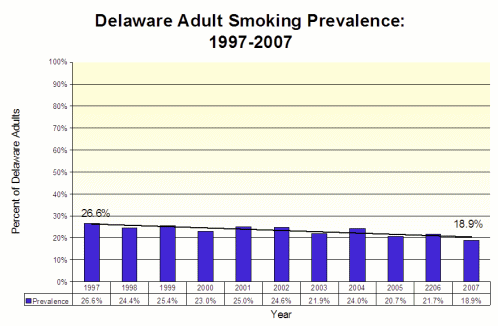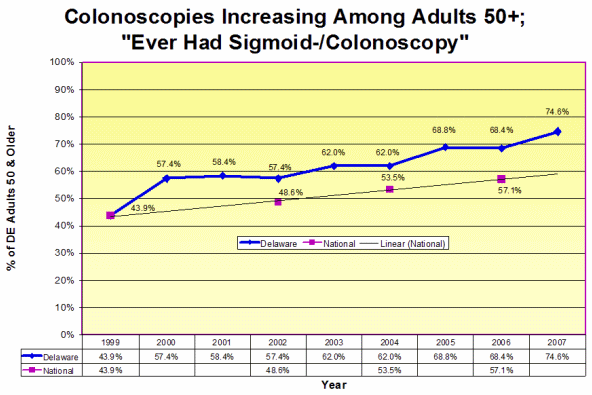Current Suspected Overdose Deaths in Delaware for 2025: Get Help Now!
Find school water testing results and additional resources
Attention Medicaid Participants: Eligibility Renewals Restarted April 1, 2023

Source: DHSS, Division of Public Health, BRFSS, 1997-2007.
Smoking prevalence in Delaware reached an all-time low in Delaware in 2007. Prevalence has been declining among both adults and youth since 1997, when a comprehensive Tobacco Prevention and Control program was initiated by the Division of Public Health and its partners in the Impact Delaware Tobacco Prevention Coalition. Activities involve community and school-based educational programs, smoking cessation services, enforcement of laws regarding sales to minors, and environmental and policy changes such as the Clean Indoor Air Act and increased excise taxes on cigarettes. Tobacco use remains the leading preventable cause of premature death and disability in Delaware and the nation.
Smoking prevalence decreased to 18.9% among Delaware adults in 2007, the lowest smoking prevalence in Delaware since the Behavioral Risk Factor Surveillance System began in 1982.
In 2007, 22.1% (CI = 20.3-23.9%) of adult Delawareans reported getting no leisure time physical activity in an average month.
A slight majority of Delaware adults are still sedentary , that is they either get no exercise or insufficient activity to meet Centers for Disease Control and Prevention (CDC) recommendations for moderate or vigorous physical activity.
The BRFS uses Centers for Disease Control and Prevention (CDC) recommendations for moderate and physical activity. The survey asks a set of questions about types, duration, and frequency of physical activity. A formula is then used to determine if respondents meet CDC recommendations for "moderate" or "vigorous" activity, or meet both sets of recommendations.
Since 2001, the prevalence of recommended physical activity has been slowly but consistently increasing among the state's adult population. The BRFS measures physical activity in odd-numbered years. The prevalence of recommended physical activity has increased from 41.5% in 2001 to 47.9% in 2007.
Obesity combines with physical inactivity as the second-leading cause of premature death and disability in Delaware and the United States. The BRFS measures uses self-reported height and weight to calculate Body Mass Index (BMI). A BMI of 25 to 29.9 is considered "overweight," while a BMI of 30 or greater is considered "obese." Because people tend to slightly under-report weight and slightly overestimate height, these prevalence rates are conservative.
In 2007, a majority of Delaware adults—65%—were either overweight or obese.
Overweight:
Overweight increases with age, from a low of 27.4% among 18-24 year olds to a 40.7% among adults age 65 and older.
Obesity:
Obesity also increases with age, from a low of 15.6% among 18-24 year olds to a high of 34.1% among adults age 55-64. About 25.1% of adults 65 and older are obese. The lower prevalence of obesity in the over-65 group may be largely attributable to premature death from lifestyle-related chronic diseases such as heart disease, stroke, lung diseases, diabetes, and cancer.
About 8.7% (CI=7.7-9.7%) of Delaware adults say they have been told by a doctor that they have diabetes. Obesity is a major risk factor for type 2 diabetes, and the trends show both obesity and diabetes increased in Delaware during the past decade. The prevalence of diabetes among adults in the state increased from 4.3% in 1995 to 8.7% in 2007.
There is no difference in prevalence by gender; but prevalence is slightly higher among African Americans than among whites:
The prevalence of diagnosed diabetes increases with age. Less than 1% of 18-24 year olds have been told they have diabetes, compared with 15.8% of 55-64 year olds and 19.7% of those 65 or older.
The majority of Delaware adults drink alcoholic beverages at least occasionally. In 2007, 58.4% (CI=56.2-60.6%) of Delaware adults say they had at least one alcoholic drink in the past month. Men (65.3%) are significantly more likely to be drinkers than women (52.1%).
18.4% (CI= 16.2-20.6%) of Delaware adults report episodes of acute heavy drinking, usually called "binge drinking ," during the past month. Binge drinking is defined as males having 5 or more drinks on one occasion, or females having four or more drinks on one occasion.
Males, and especially young adult males, report the highest levels of binge drinking. Binge drinking by gender and age:
There was no statistically significant difference on "Binge drinking" by racial group:
7.1% (CI=5.5-8.7%) of adult Delawareans are at risk due to heavy drinking. Chronic heavy drinking is defined as adult men who average more than two drinks a day, or adult women who average more than one drink a day. Breakdowns for heavy drinking:
Although males are slightly more likely to report heavy drinking than females, it is not a statistically significant difference. There were no differences on heavy drinking among racial or ethnic groups in 2007.
About 41% (CI= 38.8-43.2%) of Delaware adults said they had an influenza ("flu") shot during the past year. This is up from 28.2% in 2005 and 35.3% in 2006.
Women were slightly more likely to have a flu shot than men; with 43.2% of women and 38.7% of men reporting the shot in the past 12 months.
By race:
Influenza shots are recommended for adults with chronic diseases and adults 50 and older (especially those 65 and older), as well as for young children. Appropriately, the prevalence of flu immunization is higher among older adults:
Health officials also recommend pneumonia vaccine for older adults and individuals of all ages with chronic diseases. Pneumonia vaccine does not need to given annually. You should check with your physician or health care provider to see if you need it.
Hepatitis B
In 2007, the BRFS also added questions about Hepatitis B vaccine.
Risk factors for Hepatitis B (similar to risk factors for HIV/AIDS) include: having hemophilia or receiving clotting factor concentrate, men having sex with men, taking street drugs with needles, trading sex for money, testing positive for HIV, sex with people who have these risk factors, or having sex with more than two partners in the past year.
Among Delaware adults under 65 years of age, 47.2% (CI= 44.5-49.9%) say they have been tested at some time for the Human Immunodeficiency Virus (HIV) that causes AIDS. This does not include tests done as part of a blood donation.
Neither educational level nor income seems to influence whether an individual has had an AIDS test.
30.2% (CI=25.1-35.3%)of those who had been tested said their most recent test had been within the past year.
Another 42.9% (CI= 38.0-47.8%) said they had been test in the preceding five years (2002-2006).
The majority said they had been tested at a doctor's office or HMO (41%) or at a hospital or clinic (39%); and another 4.9% said they had been tested at a drug treatment facility.
The BRFS estimates that 7.8% (CI= 6.6-9.0%) of Delaware adults—or about 51,647adults—currently have asthma .
Selected asthma breakdowns for 2007:
Another 3.7% (CI=2.7-4.7%) of Delaware adults have been told that they have asthma but do not currently have symptoms.
The Behavioral Risk Factor Survey also asks questions about screening tests for several types of cancer:

Source: DHSS, Division of Public Health, BRFSS, 1997-2007.
The BRFS asks about how respondents feel about their own health. Other studies have validated that this is a good measure of quality of health in the population. Only 13% (C.I. 11.6% - 14.4%) say they are in "fair or poor" health. There are no statistically significant differences between men and women or among racial-ethnic populations.
About 6.5% (C.I. 5.1% - 7.9%) of Delaware adults said poor physical or mental health kept them from doing their usual activities during all or most of the past month.
In 2007, 9.1% (C.I. 7.5% - 10.7%) of Delaware adults did not have health insurance of any type.
Some adults may have health insurance, but still be unable to pay for needed health care. About 10.6% (C.I. 9% - 12.2%) reported that, at some time in the past year, they needed to see a doctor but couldn't because of cost.
| Risk Factors | New Castle | Kent | Sussex |
|---|---|---|---|
| Sedentary Lifestyle – No Leisure Time Exercise | 21% (18.3-23.7) | 24.7% (21.8-27.6) | 23.2% (20.3-26.1) |
| Get Recommended Moderate or Vigorous Physical Activity | 47.5% (44-51) | 48.5% (45-52) | 49% (45.3-52.7) |
| Adult Obesity (BMI 30 or higher) | 25.8% (22.9-28.7) | 32.7% (29.6-35.8) | 32% (28.5-35.5) |
| Overweight (BMI 25-29.9) | 37.1% (33.6-40.6) | 35.5% (32.4-38.6) | 37.2% (33.9-40.5) |
| "Fair or Poor" Health | 11.5% (9.5-13.5) | 13.7% (11.7-15.7) | 16.6% (14.2-19.0) |
| Adults With Diabetes | 7.5% (6.1-8.9) | 9.4% (7.6-11.2) | 11.4% (9.4-13.4) |
| Currently Have Asthma | 7.2% (5.4-9.0) | 8.4% (6.6-10.2) | 9.2% (7.2-11.2) |
| Currently Smoke Cigarettes | 17.2% (14.7-19.7) | 24.2% (21.1-27.3) | 19.8% (16.9-22.7) |
| Chronic Heavy Drinkers | 8% (5.5-10.5) | 5.9% (4.1-7.7) | 5.5% (3.7-7.3) |
| Binge Drinkers | 19.9% (16.8-23) | 17.1% (14-20.2) | 16.2% (13.1-19.3) |
| No Health Insurance | 6.2% (4.4-8) | 12.1% (9.4-14.8) | 8.3% (6.3-10.3) |
| Had Flu Shot Past Year (age 65 and older only) | 70.8% (65.3-76.3) | 77.9% (72.8-83) | 76.6%(72.1-81.1) |
| Ate 5 or More Fruits-Veggies A Day | 22.3% (19.2-25.4) | 18.9% (16.4-21.4) | 20.4%(17.7-23.1) |
| Limited Activity Due To Physical or Mental Problem | 20.4% (17.3-23.5) | 18.7% (16.3-21.1) | 23%(20.1-25.9) |
| Limited Activity: Need Special Equipment | 7.3% (4.9-9.7) | 6.9% (5.3-8.5) | 8.3% (6.7-9.8) |
Source: Delaware Health and Social Services, Division of Public Health, Behavioral Risk Factor Surveillance System (BRFSS), 2007.
Notes: Sample = ˜4,000 Delaware adults age 18 and older. Confidence interval (C.I.) is the range within which the true prevalence will occur with 95% confidence. When the sample size is small, for example for Delaware's Hispanic population, the confidence interval is larger. Estimates are not presented when the unweighted sample size for the denominator is less than 50, or when the confidence interval half-width is greater than 10. The Behavioral Risk Factor Survey is a random sample telephone interview survey, conducted continuously throughout the year. Additional information is available on this website or the BRFSS website of the Centers for Disease Control and Prevention.